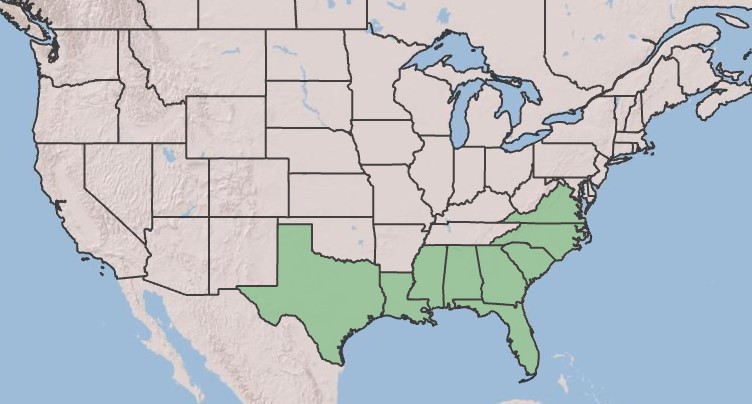Difference between revisions of "Ilex coriacea"
(→Taxonomic Notes) |
(→Habitat) |
||
| (2 intermediate revisions by the same user not shown) | |||
| Line 28: | Line 28: | ||
==Distribution== | ==Distribution== | ||
==Ecology== | ==Ecology== | ||
| − | + | ===Habitat=== | |
| + | ''I. coriacea'' occurs in natural ecosystems such as pine savannas, pine-magnolia woodlands, pine-palmetto flatwoods, mixed hardwood hammocks, cypress-gum depressions, evergreen shrub bays, stream banks, and Titi swamps. It can also be found growing along forest edges or right-of-ways. ''I. coriacea'' tends to grow in mesic, sandy to loamy soils.<ref name = fsu> Florida State University Robert K. Godfrey Herbarium database. URL: http://herbarium.bio.fsu.edu. Last accessed: June 2023. Collectors: Loran C. Anderson, A. F. Clewell, Robert K. Godfrey, Bruce Hansen, JoAnn Hansen, E. A. Hebb, Richard D. Houk, Ann F. Johnson, R. Kral, R. L. Lazor, Sidney McDaniel, and N. J. Summerlin. States and counties: Florida: Bay, Franklin, Gadsden, Gulf, Jackson, Jefferson, Leon, Liberty, Marion, Okaloosa, Osceola, Santa Rosa, Wakulla, and Walton.</ref> | ||
| + | |||
| + | Associated species of ''I. coriacea'' include ''[[Ilex glabra]]'', ''[[Ilex myrtifolia]]'', ''[[Quercus chapmanii]]'', ''[[Quercus geminata]]'', ''[[Lyonia fruticosa]]'', ''[[Lyonia lucida]]'', ''[[Serenoa repens]]'', ''[[Cliftonia monophylla]]'', ''[[Persea palustris]]'', ''Myrica cerifera'', ''[[Aronia arbutifolia]]'', ''[[Cyrilla racemiflora]]'', and ''Smilax laurifolia''.<ref name=fsu/><!--Natural communities, human disturbed habitats, topography, hydrology, soils, light, fire regime requirements for removal of competition, etc.--> | ||
<!--===Phenology===--> <!--Timing off flowering, fruiting, seed dispersal, and environmental triggers. Cite PanFlora website if appropriate: http://www.gilnelson.com/PanFlora/ --> | <!--===Phenology===--> <!--Timing off flowering, fruiting, seed dispersal, and environmental triggers. Cite PanFlora website if appropriate: http://www.gilnelson.com/PanFlora/ --> | ||
<!--===Seed dispersal===--> | <!--===Seed dispersal===--> | ||
Latest revision as of 14:06, 15 June 2023
| Ilex coriacea | |
|---|---|
| Scientific classification | |
| Kingdom: | Plantae |
| Division: | Magnoliophyta - Flowering plants |
| Class: | Magnoliopsida - Dicotyledons |
| Order: | Celastrales |
| Family: | Aquifoliaceae |
| Genus: | Ilex |
| Species: | I. coriacea |
| Binomial name | |
| Ilex coriacea (Pursh) Chapman | |

| |
| Natural range of Ilex coriacea from USDA NRCS [1]. | |
Common name: large gallberry, big gallberry, sweet gallberry
Contents
Taxonomic Notes
Synonyms: none[1]
Varieties: none[1]
Description
Distribution
Ecology
Habitat
I. coriacea occurs in natural ecosystems such as pine savannas, pine-magnolia woodlands, pine-palmetto flatwoods, mixed hardwood hammocks, cypress-gum depressions, evergreen shrub bays, stream banks, and Titi swamps. It can also be found growing along forest edges or right-of-ways. I. coriacea tends to grow in mesic, sandy to loamy soils.[2]
Associated species of I. coriacea include Ilex glabra, Ilex myrtifolia, Quercus chapmanii, Quercus geminata, Lyonia fruticosa, Lyonia lucida, Serenoa repens, Cliftonia monophylla, Persea palustris, Myrica cerifera, Aronia arbutifolia, Cyrilla racemiflora, and Smilax laurifolia.[2]
Conservation, cultivation, and restoration
Cultural use
Photo Gallery
References and notes
- ↑ 1.0 1.1 Weakley, A.S. 2020. Flora of the Southeastern United States. Edition of 20 October 2020. University of North Carolina at Chapel Hill, Chapel Hill, North Carolina.
- ↑ 2.0 2.1 Florida State University Robert K. Godfrey Herbarium database. URL: http://herbarium.bio.fsu.edu. Last accessed: June 2023. Collectors: Loran C. Anderson, A. F. Clewell, Robert K. Godfrey, Bruce Hansen, JoAnn Hansen, E. A. Hebb, Richard D. Houk, Ann F. Johnson, R. Kral, R. L. Lazor, Sidney McDaniel, and N. J. Summerlin. States and counties: Florida: Bay, Franklin, Gadsden, Gulf, Jackson, Jefferson, Leon, Liberty, Marion, Okaloosa, Osceola, Santa Rosa, Wakulla, and Walton.